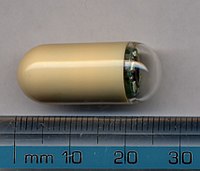
Photo from wikipedia
The invention of video capsule endoscopy at the turn of the millennium revolutionized imaging of the small bowel. 1 What was once considered an inaccessible portion of the gastrointestinal tract… Click to show full abstract
The invention of video capsule endoscopy at the turn of the millennium revolutionized imaging of the small bowel. 1 What was once considered an inaccessible portion of the gastrointestinal tract could now be viewed endoscopically in its entirety. Despite the advances made during the past 2 decades, capsule endoscopy remains hindered by 2 major factors: the highly subjective nature of capsule reading and the amount of time required to review a video. The first problem results from a lack of standardization in describing findings in the small bowel, whereas the latter is due to the amount of time required for the capsule to transit through the small intestine, which is often many hours. As a result, 2 capsule endoscopists reading the same video may offer differing reports, despite each spending considerable time reviewing the study. The solution may lie in artificial intelligence (AI), given its ability to perform time-consuming, repetitive tasks quickly in a standardized fashion. 2 Xie et al 3 report their findings on the use of AI-assisted small bowel capsule endoscopy. The investigators used a large registry of small bowel capsule endoscopy videos from 51 Chinese medical centersbetween2012and2020toform2groups:atrainingdataset(2927videos)andavalidation data set (2898 videos). The former was used to develop a convolutional neural network algorithm to detect small bowel abnormalities and the latter was used to validate the algorithm. In the validation stage, videos were read in a conventional manner by a capsule endoscopist, followed by AI-assisted review some months later. When the findings from the conventional review and AI-assisted review were discordant, adjudication by a separate group of expert readers was used. There were a total of 6084 findings among the 2898 videos in the validation cohort; conventional reading detected 4630 abnormalities (76.1%), whereas AI-assisted review detected 5834 abnormalities (95.9%). Most discordant videos were the result of a normal designation on conventional review, whereas AI assistance detected
Journal Title: JAMA network open
Year Published: 2022
Link to full text (if available)
Share on Social Media: Sign Up to like & get
recommendations!